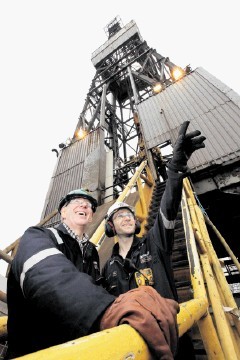
A $350million injection from private equity business Riverstone has given Fairfield Energy just the boost it needs – and the timing couldn’t have been better, its boss tells reporter Elaine Maslin.
For Fairfield Energy a $350million pot of private equity cash could not have come at a better time.
The independent is about to embark on a three-well appraisal programme to assess the scale of its Darwin discovery – an area encompassing the southern half of the former North West Hutton field and additional acreage to the south of that.
But while Darwin is likely to dominate Fairfield’s story this year, there’s a lot more to come, says chief operating officer Ian Sharp.
The cash, $350million from Riverstone, will come in two tranches – $150million to spend on the existing business, notably Dunlin, Crawford and Darwin, and then $200million to “broaden and deepen” the firm’s portfolio.
After a lot of soul searching post the firm’s failed 2010 IPO, the cash will help create a new more balanced Fairfield, with exploration, development and production in its portfolio.
“When we formed in 2008, exploration was not a core part of the company,” said Sharp. “It was looking at existing resources difficult to produce. Clipper South (in the southern North Sea) is an example of that.
“But we have recognised, whether it is private equity or the market, there is a demand for more upside so you will see us be more explicitly engaged in exploration.
“(Existing investor) Warburg Pincus and Riverstone are both investing in growth in the long term and we have a clear mandate from the board to be thoughtful and careful but to use it to broaden and deepen the portfolio.”
Sharp says Riverstone’s timing was good.
Fairfield has recently completed a gas import power project on Dunlin, securing a more consistent power supply for the platform for water injection, and, following the 2012 Budget – in which the Treasury pledged to finally end uncertainty over decommissioning relief – the firm is hoping tens of millions held in the form of securitisation could be freed up.
“We have proved we have turned a corner on Dunlin and we expect to go back to drilling in September this year,” said Sharp.
This will include testing the Rannoch reservoir, a shallower zone in the Dunlin area.
Having got to first gas on the Clipper South project (which it gradually farmed down to RWE, who eventually took over as operator and were due to bring on first gas at publication the firm is also looking to apply lessons it has learned on tight gas in the Southern North Sea.
Sharp says on Clipper South the firm has used a new way of applying fracking technology he hopes the firm could now use on other fields previously abandoned.
The first well on the field, with a reservoir permeability of one millidarcy, applied multi-stage fracturing, with each fracture plugged before the next was carried out. Once all were completed the plugs were drilled and washed out before letting the gas flow – at a rate Sharp says matched and even exceeded expectations.
Five 8,000ft deep horizontal wells, with an option for a sixth, are planned from an unmanned installation with the gas exported via ConocoPhillips’ LOGGS facility. It is estimated to have a 15-year life with peak production of about 92million cu ft per day.
Gas in place had been estimated as 523billion cu ft with base case estimated reserves of 173billion cu ft.
It had been found by Shell in 1983 who later appraised the field in 1992, but did not develop it.
“We think there is an opportunity in the Southern North Sea,” says Sharp. “We absolutely believe we have the right play in that area. We very nearly made it to first gas on Clipper South without having to put much money in having built up the seismic. In the 27th round we think we will very much be a player in that area.
“For the company the 26th and 27th rounds are looking at the Southern North Sea and tight gas. The timing is perfect, we have proved the technology at a great time.”
Fairfield has already picked up the Glein and Ensign Flank prospects, both close to existing infrastructure, and hopes for more in the 27th, but would also look to pick up blocks perhaps left fallow by others, said Sharp.
Fairfield also wants to build its presence in the Central North Sea, he says, through either exploration or through corporate activity.
Here it is already working on the Crawford development, through a carried position with operator EnQuest, who is working up a field development plan for sanction later in the year.
The original concept had been a multilateral wells with a subsea tie-back to Brae but it is understood the tie-back to Brae option is being reassessed.
Despite having cash and lots to go at, Sharp is not complacent. He’s wary that while the UK Treasury has signalled its willingness to sort out decommissioning uncertainty, the industry – not a stranger to protracted negotiations – will need to play its part and not create unnecessary delays or hurdles to a swift resolution.
Meanwhile, Darwin – with 500million barrels estimated in place – is likely to dominate Fairfield’s story. Subject to the three wells planned this year, there is potential for another two next year, with the help of farm-in partner Taqa, says Sharp.
“It could be a substantial development,” he says, “if we have a development the size we think we want.”